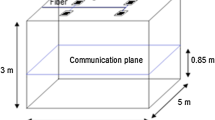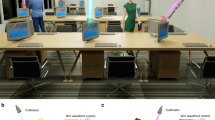Abstract
We evaluate transmission link performance for a Multi-Spot Diffusing Configuration (MSDC) for indoor wireless optical LANs. MSDC utilizes a multibeam transmitter and a composite receiver consisting of 7 narrow field-of-view (FOV) branches. Numerical evaluation is performed for two values of the receiver FOV corresponding to the cases when at least one or two diffusing spots are covered by a branch. Required optical power is used as a measure for MSDC link evaluation. The composite receiver provides angle diversity, which allows implementation of effective combining techniques. Selection Combining (SC) and Maximal Ratio Containing (MRC) methods have been analyzed. Our simulation results show that MSDC can reach much higher bit rates than a diffuse link can, without any channel equalization. MSDC link employing angle diversity receiver with larger FOV (each receiver branch capturing at least two diffusing spots) and using MRC method shows a promising performance for up to several hundreds of Mbps. System robustness against shadowing and blockage is also investigated. MSDC is more robust when an obstacle is located near the receiver, while this may cause severe problems in a diffuse link.
Similar content being viewed by others
REFERENCES
J. M. Kahn and J. R. Barry, “Wireless Infrared Communications,” Proceedings of IEEE, Vol. 85, pp. 265–298, Feb. 1997.
G. Yun and M. Kavehrad, “Spot diffusing and fly-eye receivers for indoor infrared wireless communications,” Proceedings of IEEE International Conference on Selected Topics in Wireless Communications, pp. 262–265, 1992.
J. B. Carruthers and J. M. Kahn, “Angle diversity for non-directed wireless infrared communication,” Proceedings of IEEE International Conference on Communications, Atlanta, Georgia, Conference Record, Vol. 3, pp. 1665–1670, June 1998.
M. R. Pakravan and M. Kavehrad, “Design considerations for broadband indoor infrared wireless communication systems,” International Journal of Wireless Information Networks, Vol. 2, No. 4, pp. 223–237, 1995.
Keang-Po Ho and J. M. Kahn, “Compound parabolic concentrators for narrow-band wireless infrared receivers,” Optical Engineering, Vol. 34, No. 5, pp. 1385–1395.
A. P. Tang, J. M. Kahn, and Keang-Po Ho, “Wireless infrared communication links using multi-beam transmitters and imaging receivers,” Proceedings of IEEE International Conference on Communications, Dallas, TX, pp. 180–186, June 1996.
R. T. Valadas and A. M. de Oliveira Duarte, “Sectored receivers for indoor wireless optical communication system,” 5th IEEE International Symposium On Personal, Indoor and Mobile Radio Communications, The Hague, The Netherlands, Joint PIMRC '94/WCN-Proceedings, Vol. 4, pp. 1090–1095, Sept. 1994.
A. Tavares, R. T. Valadas, and A. M. de Oliveira Duarte, “Performance of an optical sectored receiver for indoor wireless communication systems in presence of artificial and natural noise sources,” SPIE, Vol. 2601, pp. 264–273, 1995.
E. Simova, M. Tai, and M. Kavehrad, “Indoor wireless infrared link with a holographic multiple-spot diffuser,” Applications of Photonic Technology, Vol. 2, Plenum Press, New York, pp. 223–228, 1996.
M. R. Pakravan, E. Simova, and M. Kavehrad, “Holographic diffusers for indoor infrared communication systems,” International Journal of Wireless Information Networks, Vol. 4, No. 4, pp. 259–274, 1997.
S. Jivkova and M. Kavehrad, “Indoor wireless infrared local access, multi-spot diffusing with computer generated holographic beam-splitter,” Proceedings of ICC '99, Vancouver, June 1999.
J. R. Barry, Wireless infrared communications, Kluwer Academic Publishers, Boston, 1994.
G. P. Agrawal, Fiber-Optic Communication Systems, Wiley-Interscience Publication, 2nd Ed., Chap. 4, 1997.
R. G. Smith and S. D. Personick, Semiconductor Devices for Optical Communications, H. Kressel, Ed., Springer-Verlag, New York, 1980.
B. L. Kasper, Optical Fiber Telecommunications-II, S. E. Miller and I. P. Kaminow, Eds., Academic Press, Boston, Chap. 18, 1988.
S. Jivkova and M. Kavehrad, “Multi-spot diffusing configuration for wireless infrared access: joint optimization of multi-beam transmitter and angle diversity receiver,” Proc. of SPIE International Symposium on Voice, Video, and Data Communications, Photonics East'99, Vol. 3850, pp. 72–77, 1999.
D. G. Brennan, “Linear Diversity Combining techniques,” Proceedings of IRE, Vol. 47, pp. 1075–1102, 1959.
Author information
Authors and Affiliations
Rights and permissions
About this article
Cite this article
Jeong, W., Kavehrad, M. & Jivkova, S. Broadband Infrared Access with a Multi-Spot Diffusing Configuration: Performance. International Journal of Wireless Information Networks 8, 27–36 (2001). https://doi.org/10.1023/A:1011381528988
Issue Date:
DOI: https://doi.org/10.1023/A:1011381528988




